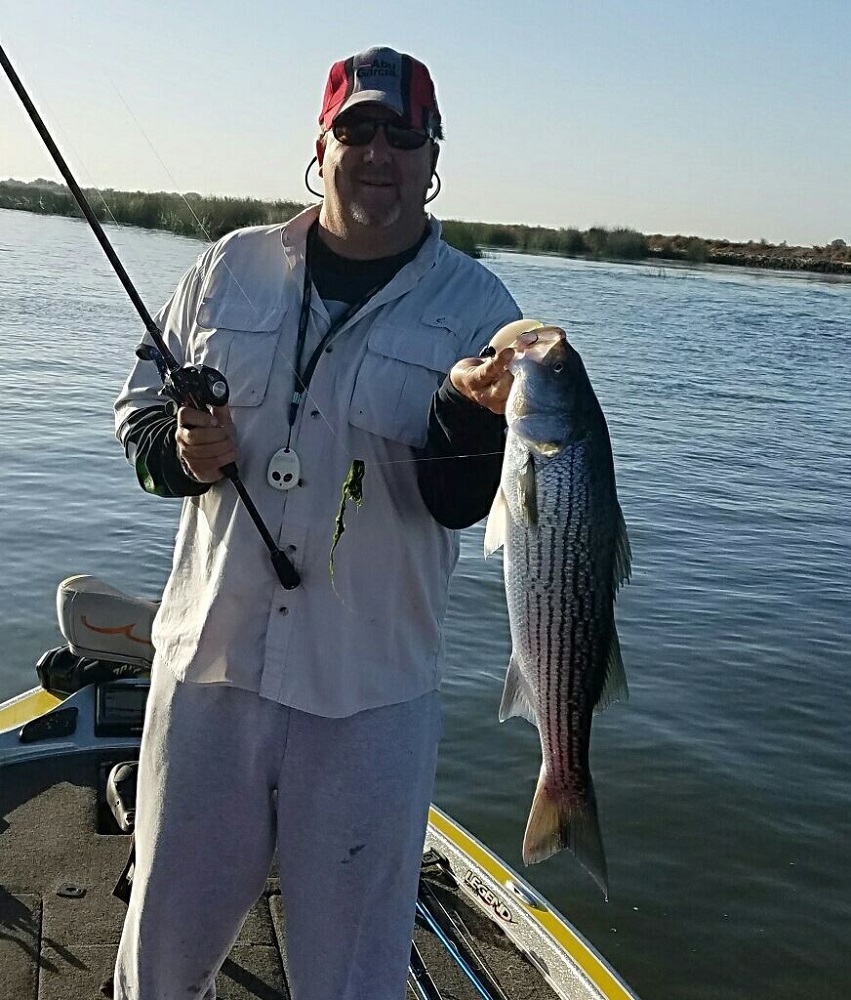
Presented by Fisherman’s Warehouse
Each year, the winter striped bass run gathers angler to the California Delta. Randy Pringle, also known as “The Fishing Instructor,” has been guiding on the fishery for over 30 years for both striped and largemouth bass. He has seen many runs in his time as a guide and has a cold weather approach for stripers that covers shallow to deep to ensure his clients can hook into fish each trip.
When and Where
According to Pringle, there is no set time when the stripers make their move. They do not have calendars after all, and water temperature is the biggest key.
“The general rule is that they start to make their move into the middle Delta in October and it lasts until January; but if it is a hot September, they are going to stay further out towards San Francisco longer before start migrating,” he says.
He has also learned through decades of experience that the bigger fish tend to bite better when the water is cold and that they are often caught in shallow water.
“The bigger fish show up when the water is cooler. I have also learned that where you catch them one day might only be smaller ones the next day,” he says about their continual move up the river.
“The 0- to 10-foot zone is also where most of the biggest fish are caught, and that has to do with their food source. A 15-pound striper cannot live on tiny shad; they are up around the grass eating bluegill, catfish, bass and whatever else they can find.”
He looks for current and says the tide is not as crucial as long as it is moving one way or another.
“I always say that when someone asks which tide is best. As long as it is moving it is going to position the fish,” he shares. “Stripers have to keep moving and can’t sit in one spot like a largemouth can.”
Pringle looks for any place that the current deflects. Weedlines, points, rock jetties, mud banks, turns in the river and more are all likely locations to find stripers.
 Picking Baits for Delta Stripers
Picking Baits for Delta Stripers
Pringle says he likes to keep bait selection simple and he is ready with everything from topwaters to big spoons.
Topwater and Rip Baits
The ima Big Stik and Little Stik are two pencil popper style baits that Pringle and his clients have used to land countless striped bass.
“These are big predator style baits. I’ll use the Big Stik and the new Sardine colored Little Stik because they made it a saltwater version with beefier hooks,” he says.
One tip Pringle mentioned for this, and all striper lures is to vary your cadence.
“You want to mix it up because the fish often track the lure a long way and are waiting for a slight change. Work it like an injured fish because they are always looking for the weakest link and the easiest meal,” adds the guide.
Pringle also likes a big saltwater jerkbait called the ima Gyodo 130 MD which anglers use for albacore and other saltwater species. He says it works equally well for Delta stripers and says he will also break the cadence up during the retrieve.
Swimbaits
When targeting stripers, Pringle often has a jighead, and swimbait rigged up for his clients. “The 4” AA’s Bad Bubba Shad on a ½ ounce gets bites. The 5” and 6” version work too, but you don’t get nearly as many bites,” he believes. (Randy Pringle "The Fishing Instructor" put his client on the big striper to the right with the AA's Bad Bubba Shad)
Generally, he sticks with the ½-ounce jighead for 12-feet or less and likes it because it allows him to fish both shallow and deep. If he gets past the 12-foot zone, he will use a ¾ ounce. When it comes to colors, he uses the White with Chartreuse Tail and a number of shad patterns.
“The biggest key with fishing the swimbaits is making sure you have tail movement. You want that ‘tick tock’ kicking back and forth. I always have my clients fish it right by the side of the boat to watch it to make sure they are not fishing it too fast or too slow,” he says.
When the Bite Slows
If the fish are not active up shallow, Pringle will often take his clients out deep and jig for stripers with a spoon.
“That 15- to 35-foot zone is where you will often find big schools of them and a jigging spoon is one of the most effective ways to target them,” he believes.
He likes the two and three-ounce P-Line Laser Minnow in the Chartreuse and Silver or Silver Blue colors.
An Old School Bait That Still Works
The Blakemore Road Runner has been around for years, and Pringle still uses it for his striper fishing trips. He uses the bucktail version and adds a simple curly tail grub, but will also rig up a more weedless version if the conditions warrant it.
“You can add a Hitch Hiker screw to the eye of the hook and add on a worm and worm and Texas-rig it to keep it weedless. This lets you fish it around logs, stumps, and tules,” adds Pringle.
This is the time of year when the big stripers invade the Delta. They have for years and will continue to do so every winter. Randy Pringle was willing to share his approach to help you make the most of this year’s striper run.
Shop these baits and more at Fishermans Warehouse Megastore


 Advertising
Advertising